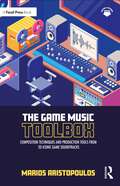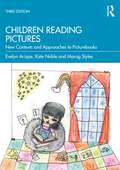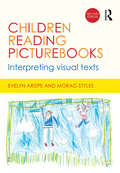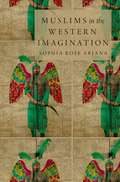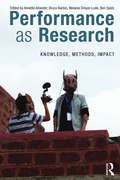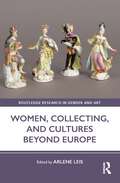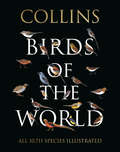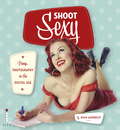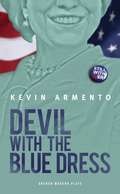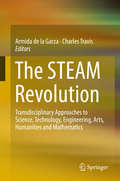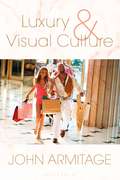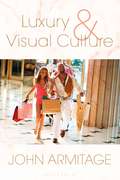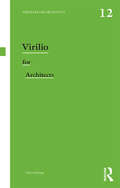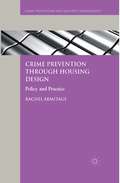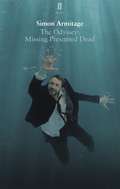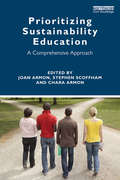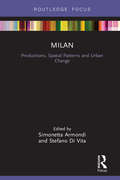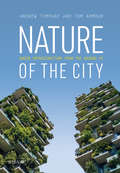- Table View
- List View
The Game Music Toolbox: Composition Techniques and Production Tools from 20 Iconic Game Soundtracks
by Marios AristopoulosThe Game Music Toolbox provides readers with the tools, models, and techniques to create and expand a compositional toolbox, through a collection of 20 iconic case studies taken from different eras of game music. Discover many of the composition and production techniques behind popular music themes from games such as Cyberpunk 2077, Mario Kart 8, The Legend of Zelda, Street Fighter II, Diablo, Shadow of the Tomb Raider, The Last of Us, and many others. The Game Music Toolbox features: Exclusive interviews from industry experts Transcriptions and harmonic analyses 101 music theory introductions for beginners Career development ideas and strategies Copyright and business fundamentals An introduction to audio implementation for composers Practical takeaway tasks to equip readers with techniques for their own game music The Game Music Toolbox is crucial reading for game music composers and audio professionals of all backgrounds, as well as undergraduates looking to forge a career in the video game industry.
Children Reading Pictures: New Contexts and Approaches to Picturebooks
by Evelyn Arizpe Kate Noble Morag StylesChildren Reading Pictures: New Contexts and Approaches to Picturebooks offers up-to-date research evidence on the responses of the primary audience for picturebooks – children. The new edition has retained the best of the original while expanding its scope in several directions, including the role of the art museum in helping children and their teachers to broaden and deepen their appreciation of the visual, and the significance of understanding diversity and inclusion while looking at illustrations in picturebooks, in digital form and in the art museum. In particular, the third edition: uses new case studies to bring to life exciting initiatives from teachers and art museum educators in the UK and beyond, examining the potential of picturebooks for overcoming cultural, educational, linguistic and other barriers in the classroom and in other settings; continues to draw readers’ attention to significant international theoretical work in the field and provides structured advice for teachers and graduate students who wish to carry out their own research; focuses on new research with pupils, teachers, art educators and researchers working on young people’s responses to a variety of visual texts, including digital forms and fine art, and through children’s own artistic creations, to develop a more nuanced understanding of visual literacy; celebrates the glorious variety of outstanding picturebooks and their makers who offer rich challenge, amusement, pleasure and consolation to young readers in a changing, often troubling world. Children Reading Pictures is essential reading for undergraduate and postgraduate students of education, art and children’s literature, as well as providing important information for primary and early years teachers, literacy coordinators and for all those interested in picturebooks and visual literacy.
Children Reading Pictures: New Contexts and Approaches to Picturebooks
by Evelyn Arizpe Kate Noble Morag StylesChildren Reading Pictures: New Contexts and Approaches to Picturebooks offers up-to-date research evidence on the responses of the primary audience for picturebooks – children. The new edition has retained the best of the original while expanding its scope in several directions, including the role of the art museum in helping children and their teachers to broaden and deepen their appreciation of the visual, and the significance of understanding diversity and inclusion while looking at illustrations in picturebooks, in digital form and in the art museum. In particular, the third edition: uses new case studies to bring to life exciting initiatives from teachers and art museum educators in the UK and beyond, examining the potential of picturebooks for overcoming cultural, educational, linguistic and other barriers in the classroom and in other settings; continues to draw readers’ attention to significant international theoretical work in the field and provides structured advice for teachers and graduate students who wish to carry out their own research; focuses on new research with pupils, teachers, art educators and researchers working on young people’s responses to a variety of visual texts, including digital forms and fine art, and through children’s own artistic creations, to develop a more nuanced understanding of visual literacy; celebrates the glorious variety of outstanding picturebooks and their makers who offer rich challenge, amusement, pleasure and consolation to young readers in a changing, often troubling world. Children Reading Pictures is essential reading for undergraduate and postgraduate students of education, art and children’s literature, as well as providing important information for primary and early years teachers, literacy coordinators and for all those interested in picturebooks and visual literacy.
Children Reading Picturebooks: Interpreting visual texts
by Evelyn Arizpe Morag StylesChildren Reading Pictures has made a huge impact on teachers, scholars and students all over the world. The original edition of this book described the fascinating range of children's responses to contemporary picturebooks, which proved that they are sophisticated readers of visual texts and are able to make sense of complex images on literal, visual and metaphorical levels. Through this research, the authors found that children are able to understand different viewpoints, analyse moods, messages and emotions, and articulate personal responses to picture books - even when they struggle with the written word.The study of picturebooks and children’s responses to them has increased dramatically in the 12 years since the first edition was published. Fully revised with a review of the most recent theories and critical work related to picturebooks and meaning-making, this new edition demonstrates how vital visual literacy is to children's understanding and development. The second edition: Includes three new case studies that address social issues, special needs and metafiction Summarises key finding from research with culturally diverse children Draws upon new research on response to digital picturebooks Provides guidelines for those contemplating research on response to picturebooks This book is essential reading for undergraduate and postgraduate students of children’s literature as well as providing important reading for Primary and Early Years teachers, literacy co-ordinators and all those interested in picturebooks.
Children Reading Picturebooks: Interpreting visual texts
by Evelyn Arizpe Morag StylesChildren Reading Pictures has made a huge impact on teachers, scholars and students all over the world. The original edition of this book described the fascinating range of children's responses to contemporary picturebooks, which proved that they are sophisticated readers of visual texts and are able to make sense of complex images on literal, visual and metaphorical levels. Through this research, the authors found that children are able to understand different viewpoints, analyse moods, messages and emotions, and articulate personal responses to picture books - even when they struggle with the written word.The study of picturebooks and children’s responses to them has increased dramatically in the 12 years since the first edition was published. Fully revised with a review of the most recent theories and critical work related to picturebooks and meaning-making, this new edition demonstrates how vital visual literacy is to children's understanding and development. The second edition: Includes three new case studies that address social issues, special needs and metafiction Summarises key finding from research with culturally diverse children Draws upon new research on response to digital picturebooks Provides guidelines for those contemplating research on response to picturebooks This book is essential reading for undergraduate and postgraduate students of children’s literature as well as providing important reading for Primary and Early Years teachers, literacy co-ordinators and all those interested in picturebooks.
Muslims in the Western Imagination
by Sophia Rose ArjanaA Choice 2015 Outstanding Academic Title Throughout history, Muslim men have been depicted as monsters. The portrayal of humans as monsters helps a society delineate who belongs and who, or what, is excluded. Even when symbolic, as in post-9/11 zombie films, Muslim monsters still function to define Muslims as non-human entities. These are not depictions of Muslim men as malevolent human characters, but rather as creatures that occupy the imagination -- non-humans that exhibit their wickedness outwardly on the skin. They populate medieval tales, Renaissance paintings, Shakespearean dramas, Gothic horror novels, and Hollywood films. Through an exhaustive survey of medieval, early modern, and contemporary literature, art, and cinema, Muslims in the Western Imagination examines the dehumanizing ways in which Muslim men have been constructed and represented as monsters, and the impact such representations have on perceptions of Muslims today. The study is the first to present a genealogy of these creatures, from the demons and giants of the Middle Ages to the hunchbacks with filed teeth that are featured in the 2007 film 300, arguing that constructions of Muslim monsters constitute a recurring theme, first formulated in medieval Christian thought. Sophia Rose Arjana shows how Muslim monsters are often related to Jewish monsters, and more broadly to Christian anti-Semitism and anxieties surrounding African and other foreign bodies, which involves both religious bigotry and fears surrounding bodily difference. Arjana argues persuasively that these dehumanizing constructions are deeply embedded in Western consciousness, existing today as internalized beliefs and practices that contribute to the culture of violence--both rhetorical and physical--against Muslims.
Muslims in the Western Imagination
by Sophia Rose ArjanaA Choice 2015 Outstanding Academic Title Throughout history, Muslim men have been depicted as monsters. The portrayal of humans as monsters helps a society delineate who belongs and who, or what, is excluded. Even when symbolic, as in post-9/11 zombie films, Muslim monsters still function to define Muslims as non-human entities. These are not depictions of Muslim men as malevolent human characters, but rather as creatures that occupy the imagination -- non-humans that exhibit their wickedness outwardly on the skin. They populate medieval tales, Renaissance paintings, Shakespearean dramas, Gothic horror novels, and Hollywood films. Through an exhaustive survey of medieval, early modern, and contemporary literature, art, and cinema, Muslims in the Western Imagination examines the dehumanizing ways in which Muslim men have been constructed and represented as monsters, and the impact such representations have on perceptions of Muslims today. The study is the first to present a genealogy of these creatures, from the demons and giants of the Middle Ages to the hunchbacks with filed teeth that are featured in the 2007 film 300, arguing that constructions of Muslim monsters constitute a recurring theme, first formulated in medieval Christian thought. Sophia Rose Arjana shows how Muslim monsters are often related to Jewish monsters, and more broadly to Christian anti-Semitism and anxieties surrounding African and other foreign bodies, which involves both religious bigotry and fears surrounding bodily difference. Arjana argues persuasively that these dehumanizing constructions are deeply embedded in Western consciousness, existing today as internalized beliefs and practices that contribute to the culture of violence--both rhetorical and physical--against Muslims.
Performance as Research: Knowledge, methods, impact
by Annette Arlander Bruce Barton Melanie Dreyer-Lude Ben SpatzPerformance as Research (PAR) is characterised by an extraordinary elasticity and interdisciplinary drive. Performance as Research: Knowledge, Methods, Impact celebrates this energy, bringing together chapters from a wide range of disciplines and eight different countries. This volume focuses explicitly on three critical, often contentious themes that run through much discussion of PaR as a discipline: Knowledge - the areas and manners in which performance can generate knowledge Methods - methods and methodologies for approaching performance as research Impact - a broad understanding of the impact of this form of research These themes are framed by four essays from the book's editors, contextualising their interrelated conversations, teasing out common threads, and exploring the new questions that the contributions pose to the field of performance. As both an intervention into and extension of current debates, this is a vital collection for any reader concerned with the value and legitimacy of performance as research.
Performance as Research: Knowledge, methods, impact
by Annette Arlander Bruce Barton Melanie Dreyer-Lude Ben SpatzPerformance as Research (PAR) is characterised by an extraordinary elasticity and interdisciplinary drive. Performance as Research: Knowledge, Methods, Impact celebrates this energy, bringing together chapters from a wide range of disciplines and eight different countries. This volume focuses explicitly on three critical, often contentious themes that run through much discussion of PaR as a discipline: Knowledge - the areas and manners in which performance can generate knowledge Methods - methods and methodologies for approaching performance as research Impact - a broad understanding of the impact of this form of research These themes are framed by four essays from the book's editors, contextualising their interrelated conversations, teasing out common threads, and exploring the new questions that the contributions pose to the field of performance. As both an intervention into and extension of current debates, this is a vital collection for any reader concerned with the value and legitimacy of performance as research.
Women, Collecting, and Cultures Beyond Europe (Routledge Research in Gender and Art)
by Leis ArleneThis book examines collecting around the world and how women have participated in and formed collections globally. The edited volume builds on recent research and offers a wider lens through which to examine and challenge women’s collecting histories. Spanning from the seventeenth century to the twenty-first (although not organized chronologically) the research herein extends beyond European geographies and across time periods; it brings to light new research on how artificiallia and naturallia were collected, transported, exchanged, and/or displayed beyond Europe. Women, Collecting and Cultures Beyond Europe considers collections as points of contact that forged transcultural connections and knowledge exchange. Some authors focus mainly on collectors and what was collected, while others consider taxonomies, travel, patterns of consumption, migration, markets, and the after life of things. In its broad and interdisciplinary approach, this book amplifies women’s voices, and aims to position their collecting practices toward new transcultural directions, including women’s relation to distinct cultures, customs, and beliefs as well as exposing the challenges women faced when carving a place for themselves within global networks. This study will be of interest to scholars working in collections and collecting, conservation, museum studies, art history, women’s studies, material and visual cultures, Indigenous studies, textile histories, global studies, history of science, social and cultural histories.
Collins Birds of the World
by Norman Arlott Ber van Perlo Jorge R. Mata Gustavo Carrizo Aldo A. Chiappe Luis HuberFor the first time, the complete collection of the Collins Field Guides’ incredibly detailed, accurate and beautiful bird paintings has been brought together in one comprehensive volume.
Shoot Sexy: Pinup Photography in the Digital Age
by Ryan ArmbrustThe pinup look made famous on WWII bombers and in the 1950s has become a timeless classic that is now undergoing a revival through digital photography. Alongside the rapid growth of the Boudoir genre - also covered in this book - the retro pinup look is an increasingly popular request from clients. This book will show you all how to achieve it, whether you're shooting professionally, or just for fun.
Devil with the Blue Dress (Oberon Modern Plays)
by Kevin ArmentoThis gets called the Monica Lewinsky Scandal. You made sure everyone knew my name. January 1998: America is rocked by one of the biggest political sex scandals of all time. Slyly exhuming the little blue dress that launched the biggest media circus of a generation, the five women who were at the centre of the infamous Monica Lewinsky scandal collide on stage in this political thriller. A First Lady, a secretary, a daughter, a confidant, and an intern take us through the corridors of power and behind the closed doors where the abuse of that power took place. A theatrical battle over exactly how it all went down, DEVIL WITH THE BLUE DRESS asks who were the heroes and villains, and why, twenty years later, we’re only beginning to grapple with one of the most challenging questions in American political history: How do we respond to women seeking power, and the men who misuse it?
The STEAM Revolution: Transdisciplinary Approaches to Science, Technology, Engineering, Arts, Humanities and Mathematics
by Armida de la Garza Charles TravisThis volume is dedicated to collaborative research across STEM disciplines, the arts and humanities. It includes six sections, framed from a global perspective and exhibits contributions from key experts in the field, emerging scholarly voices, and STEAM practitioners. The added value of STEAM projects in research is highlighted in the first section of this book. Ranging from the spatial, medical and environmental humanities to heritage science, this section discusses the course and paths STEAM projects may evolve to in the near future. The second section features reflective essays by scientists and artists on the development of their research, their professional growth and personal learning experiences that the art/science collaborations have afforded their work and careers. Sections III and IV provides practical guidance and advice on facilitating STEAM teams and describe successful collaborative projects. By presenting the objectives and outcomes of relevant research, the chapters in these sections discuss the various steps taken by different teams to achieve project fruition. Paying particular attention to barriers inhibiting STEAM collaboration, these sections also explore the ways in which research teams were able to work effectively. The fifth section presents a review of policy issues and the potential impacts of STEAM research for administrators, funders and policy makers. In its pursuit for balance and inclusion, the volume concludes with a critical reflection on STEAM that argues a different perspective and will prove food for thought to readers.
Luxury and Visual Culture
by John ArmitageFrom couture fashion to opulent perfumes and decadent food, the luxury goods and services industry has grown at an unprecedented rate even in the context of a global recession. But in contemporary digital culture does luxury still reside in material things, or rather the look of things? In this first study of luxury through the lens of visual culture, Armitage argues that luxury is undergoing a shift from material culture to the immaterial culture of the visual, offering new forms of luxury engagement and unparalleled levels of pleasure never before offered to the senses.Calling for a new understanding of luxury in the changing visual landscape of contemporary society, Luxury and Visual Culture embraces an extraordinary range of cultural forms, including fashion, photography, social media, television, and art. From the masterpieces of Damien Hirst and Jeff Koons, to Richard Avedon's photography and Louis Vuitton's Flagship stores, the book explores key issues of globalization, digitization, consumer identity, “mass” luxury, and the role of art. This text is ideal for all students of contemporary luxury studies, as well as scholars and researchers in the field of visual culture.
Luxury and Visual Culture
by John ArmitageFrom couture fashion to opulent perfumes and decadent food, the luxury goods and services industry has grown at an unprecedented rate even in the context of a global recession. But in contemporary digital culture does luxury still reside in material things, or rather the look of things? In this first study of luxury through the lens of visual culture, Armitage argues that luxury is undergoing a shift from material culture to the immaterial culture of the visual, offering new forms of luxury engagement and unparalleled levels of pleasure never before offered to the senses.Calling for a new understanding of luxury in the changing visual landscape of contemporary society, Luxury and Visual Culture embraces an extraordinary range of cultural forms, including fashion, photography, social media, television, and art. From the masterpieces of Damien Hirst and Jeff Koons, to Richard Avedon's photography and Louis Vuitton's Flagship stores, the book explores key issues of globalization, digitization, consumer identity, “mass” luxury, and the role of art. This text is ideal for all students of contemporary luxury studies, as well as scholars and researchers in the field of visual culture.
Virilio for Architects (Thinkers for Architects)
by John ArmitagePaul Virilio is an innovative figure in the study of architecture, space, and the city. Virilio for Architects primes readers for their first encounter with his crucial texts on some of the vital theoretical debates of the twenty-first century, including: Oblique Architecture and Bunker Archeology Critical Space and the Overexposed City The Ultracity and Very High Buildings Grey Ecology and Global Hypermovement In exploring Virilio’s most important architectural ideas and their impact, John Armitage traces his engagement with other key architectural and scientific thinkers such as Claude Parent, Benoit B. Mandelbrot, and Bernard Tschumi. Virilio for Architects allows students, researchers, and non-academic readers to connect with Virilio’s distinctive architectural theories, critical studies, and fresh ideas.
Virilio for Architects (Thinkers for Architects)
by John ArmitagePaul Virilio is an innovative figure in the study of architecture, space, and the city. Virilio for Architects primes readers for their first encounter with his crucial texts on some of the vital theoretical debates of the twenty-first century, including: Oblique Architecture and Bunker Archeology Critical Space and the Overexposed City The Ultracity and Very High Buildings Grey Ecology and Global Hypermovement In exploring Virilio’s most important architectural ideas and their impact, John Armitage traces his engagement with other key architectural and scientific thinkers such as Claude Parent, Benoit B. Mandelbrot, and Bernard Tschumi. Virilio for Architects allows students, researchers, and non-academic readers to connect with Virilio’s distinctive architectural theories, critical studies, and fresh ideas.
Crime Prevention through Housing Design: Policy and Practice (Crime Prevention and Security Management)
by R. ArmitageThis book presents a comprehensive review of the impact of residential design on crime focusing upon research, policy and practice both in the UK and internationally, appealing to both academics and practitioners within the fields of crime prevention, urban planning and architecture.
The Odyssey: Adapted for the Stage
by Simon ArmitageA high-ranking government minister with a colourful past is sent on a diplomatic mission to Istanbul. When his trip ends up in a bar-room brawl, he becomes Europe's most wanted man overnight. Chased by the authorities, damned by religious leaders, pursued by those looking for vengeance and head-hunted by fanatics, his odyssey begins. Plunged into the ancient past, Odysseus must now contend with all the unworldly beings and unnatural phenomena that stand in his way. The Cyclops, the Sirens, witches, whirlpools and flesh-eating armies must all be overcome in the struggle for survival and the long voyage back home.Simon Armitage's The Odyssey: Missing Presumed Dead premiered at the Liverpool Everyman in September 2015 then toured the UK in a co-production with English Touring Theatre.
Prioritizing Sustainability Education: A Comprehensive Approach
by Joan Armon Stephen Scoffham Chara ArmonPrioritizing Sustainability Education presents theory-to-practice essays and case studies by educators from six countries who elucidate dynamic approaches to sustainability education. Too often, students graduate with exploitative, consumer-driven orientations toward ecosystems and are unprepared to confront the urgent challenges presented by environmental degradation. Educators are prioritizing sustainability-oriented courses and programs that cultivate students’ knowledge, skills, and values and contextualize them within relational connections to local and global ecosystems. Little has yet been written, however, about the comprehensive sustainability education that educators are currently designing and implementing, often across or at the edges of disciplinary boundaries. The approaches described in this book expand beyond conventional emphases on developing students’ attitudes, knowledge, and behaviors by thinking and talking about ecosystems to additionally engaging students with ecosystems in sensory, affective, psychological, and cognitive dimensions, as well as imaginative, spiritual, or existential dimensions that guide environmental care and regeneration. This book supports educators and graduate and upper-level undergraduate students in the humanities, social sciences, environmental studies, environmental sciences, and professional programs in considering how to reorient their fields toward relational sustainability perspectives and practices.
Prioritizing Sustainability Education: A Comprehensive Approach
by Joan Armon Stephen Scoffham Chara ArmonPrioritizing Sustainability Education presents theory-to-practice essays and case studies by educators from six countries who elucidate dynamic approaches to sustainability education. Too often, students graduate with exploitative, consumer-driven orientations toward ecosystems and are unprepared to confront the urgent challenges presented by environmental degradation. Educators are prioritizing sustainability-oriented courses and programs that cultivate students’ knowledge, skills, and values and contextualize them within relational connections to local and global ecosystems. Little has yet been written, however, about the comprehensive sustainability education that educators are currently designing and implementing, often across or at the edges of disciplinary boundaries. The approaches described in this book expand beyond conventional emphases on developing students’ attitudes, knowledge, and behaviors by thinking and talking about ecosystems to additionally engaging students with ecosystems in sensory, affective, psychological, and cognitive dimensions, as well as imaginative, spiritual, or existential dimensions that guide environmental care and regeneration. This book supports educators and graduate and upper-level undergraduate students in the humanities, social sciences, environmental studies, environmental sciences, and professional programs in considering how to reorient their fields toward relational sustainability perspectives and practices.
Milan: Productions, Spatial Patterns and Urban Change (Built Environment City Studies)
by Simonetta Armondi Stefano Di VitaAs a main urban centre of one of the most dynamic European regions, Milan is a key location from which to study narratives of innovations and contemporary productions – old and new manufacturing, tertiary and consumptive sectors, creative and cultural economy – and investigate their influence both on spatial patterns and urban policy agenda. Accordingly, this book explores the contentious geographies of innovation, productions and working spaces, both empirically and theoretically in a city that, since the beginning of the 2000s, has been involved in a process of urban change, with relevant spatial and socio-economic effects, within an increasingly turbulent world economy. Through this analysis, the book provides an insight into the complexity of contemporary urban phenomena beyond a traditional metropolitan lens, highlighting issues such as rescaling, urban decentralization and recentralization, extensive urban transformation and shrinkage and molecular urban regeneration. This book is a valuable resource for academics, researchers and scholars focusing on Urban Studies such as Urban Policy, Urban Planning, Urban Geography, Urban Economy and Urban Sociology.
Milan: Productions, Spatial Patterns and Urban Change (Built Environment City Studies)
by Simonetta Armondi Stefano Di VitaAs a main urban centre of one of the most dynamic European regions, Milan is a key location from which to study narratives of innovations and contemporary productions – old and new manufacturing, tertiary and consumptive sectors, creative and cultural economy – and investigate their influence both on spatial patterns and urban policy agenda. Accordingly, this book explores the contentious geographies of innovation, productions and working spaces, both empirically and theoretically in a city that, since the beginning of the 2000s, has been involved in a process of urban change, with relevant spatial and socio-economic effects, within an increasingly turbulent world economy. Through this analysis, the book provides an insight into the complexity of contemporary urban phenomena beyond a traditional metropolitan lens, highlighting issues such as rescaling, urban decentralization and recentralization, extensive urban transformation and shrinkage and molecular urban regeneration. This book is a valuable resource for academics, researchers and scholars focusing on Urban Studies such as Urban Policy, Urban Planning, Urban Geography, Urban Economy and Urban Sociology.
Nature of the City: Green Infrastructure from the Ground Up
by Tom Armour Andrew TempanyThis is a practical guide to delivering green infrastructure from the ground up and bringing nature in to the built environment. Exploring the process of delivery through an array of design approaches and case studies, it demystifies the concept and provides the tools for practical implementation - highlighting the challenges and opportunities on both small and large projects.
